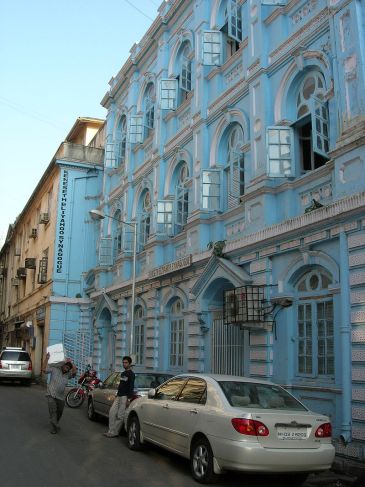One of the largest and oldest fishing docks in Mumbai, the Sassoon Docks, located in the South Mumbai area of Colaba, received a colourful makeover in 2017 as part of the ‘St+art Urban Art Festival’. While the art project paid homage to the Koli fishing community, it also brought attention to the family after whom the docks are named.

Many ultra-rich families like the Waltons, the Koch brothers, and the Rothschilds have been in the public eye, but not much attention has been paid to the Sassoon family. The Sassoons have deliberately kept a low profile, despite being one of the world’s oldest remaining banking dynasties. But this was not always the case. If you were a visitor to Bombay in the mid-1800s strolling through the wide streets, and admiring the local architecture, you would have instantly noticed that the Sassoon name popped up more than any other. It was attached to libraries, office complexes, schools, clock towers, synagogues and more. Apart from this, the family contributed considerably to Bombay’s development, employing between 15,000 and 20,000 workers in its various operations. Either directly or indirectly the Sassoons supported over half of Bombay’s households. By the 1860s, they were one of the wealthiest families in Bombay. But just who were the Sassoons and where did they come from?
In the 1800s the Sassoons were a well-respected, well-connected and wealthy Jewish family based in Baghdad, once a cultural hub in the middle east. The head of the family was a man named David Sassoon, and he had connections to the ruling powers- the Ottoman Turks. That should have meant that David Sassoon and his family were set for life, but in the 1800s, different Islamic factions were fighting each other, and the ruling Turks were slowly losing power. With the situation being so uncertain, the wisest option seemed to be for the Sassoons to move. One story goes that while walking home from the synagogue, David Sassoon was greeted by a fortune-teller who predicted that if David left Baghdad for India, he would be blessed with immense riches. Whether that is true or not, in 1832 David and his family left Baghdad and headed for Bombay.
In those days Bombay already had a thriving Baghdadi Jewish community. The title ‘Baghdadi’ was given to anyone who came to India from the middle-east. Most of these early migrants were merchants trading at ports along the Persian Gulf. These early Jewish traders weren’t really a community, but rather a loosely-organised group. All of that changed with the arrival of David Sassoon in 1833.
By 1830, the East India Company’s exclusivity over trade had ended. As soon as he arrived David quickly set up an international trading emporium and dabbled in the lucrative cotton and opium trade taking place with China. But that wasn’t what made David rich. Instead, David was quick to realise that there weren’t mills weaving fabric in Bombay. He is credited with building the first textile mill in Bombay, a small beginning which eventually made Bombay the textile capital of India in the 20th century.
After the death of David Sassoon in 1864, his eldest son, Albert Abdullah David Sassoon, took charge of the company’s Bombay operations. He designed and built his own port – the Sassoon Docks. This was the first commercial wet docks in western India. The docks were so well-conceived that much of the direct trade from England to the Far East came into the hands of David Sassoon Sons, and Company. With their fortune made, the Sassoons spread out all over the world. Albert himself moved to Europe after his marriage into the Rothschild family. The last members of the Sassoon family to leave India migrated to Israel in the early 1950s.
While they were in Bombay, the Sassoons were incredibly public-spirited. They built a number of iconic buildings like the David Sassoon Library and Reading Room, the Knesset Eliyahoo Synagogue and contributed generously to the construction of the Gateway of India. Most of these buildings are still as beautiful as when they were first built. If you want to see some of the Sassoon family’s legacy, and learn more about Mumbai’s exciting architectural history, join ‘The Bombay Story’ our walking tour through South Mumbai. You can also read more about Mumbai’s history in our story on how the British got Bombay in the first place: ‘The Marriage of Princess Catherine’.
Archives
- January 2022
- December 2021
- November 2021
- August 2021
- March 2021
- February 2021
- January 2021
- December 2020
- November 2020
- October 2020
- September 2020
- August 2020
- April 2020
- March 2020
- February 2020
- January 2020
- November 2019
- October 2019
- September 2019
- August 2019
- July 2019
- June 2019
- August 2017
- February 2017
- January 2017
- October 2013
Featured Posts
- Tales that pots tell: Keeladi excavations AUGUST 18, 2021
- The Last Grand Nawab: Wallajah FEBRUARY 10, 2021
- How Tej Singh became Raja Desingu of Gingee FEBRUARY 5, 2021
- How Shahjahan seized the Mughal throne JANUARY 28, 2021
- Alai Darwaza – Qutub Minar Complex, Delhi NOVEMBER 21, 2020
- Marking History through British buildings NOVEMBER 17, 2020
- The last great queen of Travancore NOVEMBER 7, 2020
- Brahmi and the evolution of scripts OCTOBER 15, 2020
- The Cambodian King of Kanchipuram OCTOBER 14, 2020
- James Prinsep – the man who read the writing on the wall OCTOBER 10, 2020
- Mariamman – the Village Goddess who travelled SEPTEMBER 30, 2020
- Misnamed Monuments of Mamallapuram SEPTEMBER 28, 2020








